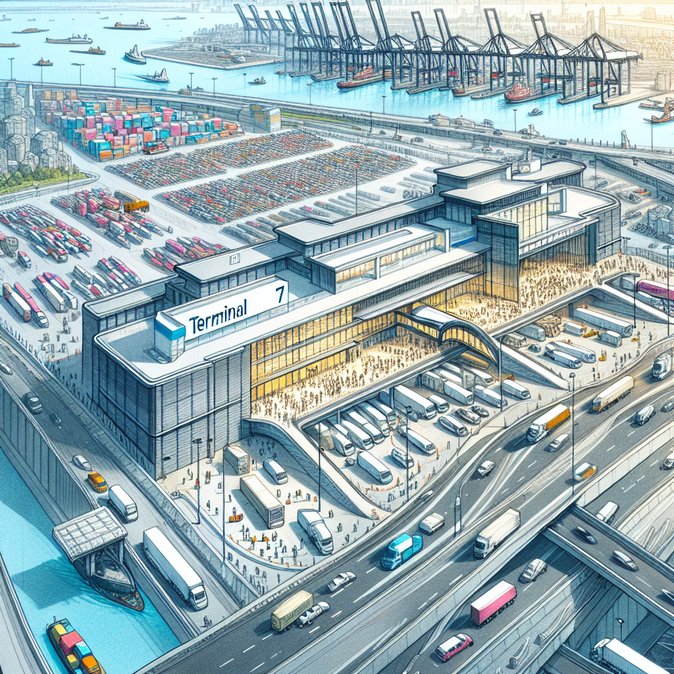
Ireland officially opened the landmark Terminal 7 Customs and Border Control Complex at Rosslare Europort on 7 November 2025. The €230 million campus replaces the temporary port-cabins that have handled post-Brexit checks since January 2021 and ushers in a single-stop process for freight, passenger ferries and coach traffic arriving from Great Britain and other non-EU origins.
Built by John Paul Construction for the Office of Public Works (OPW), the 34-building complex brings under one roof Revenue Customs, Department of Agriculture Food & the Marine (DAFM) sanitary-phytosanitary inspection bays, Health Service Executive (HSE) food-safety labs and a dedicated Garda National Immigration Bureau facility. A high-capacity drive-through scanner now allows Revenue to examine entire trucks in minutes, sharply reducing dwell times that previously stretched to two hours at peak sailings. Driver welfare blocks, secure parking and streamlined check-in lanes complete the redesign, which can process 500 HGVs per day – double the port’s 2024 throughput.
![€230 million Rosslare Europort Terminal 7 delivers permanent post-Brexit customs and immigration hub]()
For exporters the upgrade means fewer diversions to Dublin Port, cutting costly ‘land-bridge’ routings through the UK. Logistics providers told Global Mobility News that time-to-market for pharmaceuticals and agri-food consignments into mainland Europe could fall by 12-24 hours thanks to the smoother direct-to-EU route. Multinationals operating just-in-time supply chains, particularly in life sciences clusters around Waterford and Cork, are expected to benefit most.
From a compliance perspective, permanent immigration booths future-proof the State against rising passenger volumes on the France and Spain routes and align Rosslare with the EU’s forthcoming Entry/Exit System (EES) biometric checks. Carriers Stena Line and Brittany Ferries welcomed the investment, noting that predictable border formalities are essential for attracting additional sailings and maintaining Ireland’s reputation as ‘not just a last port but a first port’ for Continental trade.
Jack Chambers TD, Minister for Public Expenditure, said the complex "guarantees stable and continued access to the EU Single Market" and cited funding from the EU Brexit Adjustment Reserve as evidence of Brussels’ long-term commitment to Ireland’s external frontier. With permanent infrastructure finally in place, attention now turns to digitising customs documentation and integrating port systems with Revenue’s new Advance Goods Manifest portal, scheduled for live testing in Q2 2026.
Built by John Paul Construction for the Office of Public Works (OPW), the 34-building complex brings under one roof Revenue Customs, Department of Agriculture Food & the Marine (DAFM) sanitary-phytosanitary inspection bays, Health Service Executive (HSE) food-safety labs and a dedicated Garda National Immigration Bureau facility. A high-capacity drive-through scanner now allows Revenue to examine entire trucks in minutes, sharply reducing dwell times that previously stretched to two hours at peak sailings. Driver welfare blocks, secure parking and streamlined check-in lanes complete the redesign, which can process 500 HGVs per day – double the port’s 2024 throughput.

For exporters the upgrade means fewer diversions to Dublin Port, cutting costly ‘land-bridge’ routings through the UK. Logistics providers told Global Mobility News that time-to-market for pharmaceuticals and agri-food consignments into mainland Europe could fall by 12-24 hours thanks to the smoother direct-to-EU route. Multinationals operating just-in-time supply chains, particularly in life sciences clusters around Waterford and Cork, are expected to benefit most.
From a compliance perspective, permanent immigration booths future-proof the State against rising passenger volumes on the France and Spain routes and align Rosslare with the EU’s forthcoming Entry/Exit System (EES) biometric checks. Carriers Stena Line and Brittany Ferries welcomed the investment, noting that predictable border formalities are essential for attracting additional sailings and maintaining Ireland’s reputation as ‘not just a last port but a first port’ for Continental trade.
Jack Chambers TD, Minister for Public Expenditure, said the complex "guarantees stable and continued access to the EU Single Market" and cited funding from the EU Brexit Adjustment Reserve as evidence of Brussels’ long-term commitment to Ireland’s external frontier. With permanent infrastructure finally in place, attention now turns to digitising customs documentation and integrating port systems with Revenue’s new Advance Goods Manifest portal, scheduled for live testing in Q2 2026.










